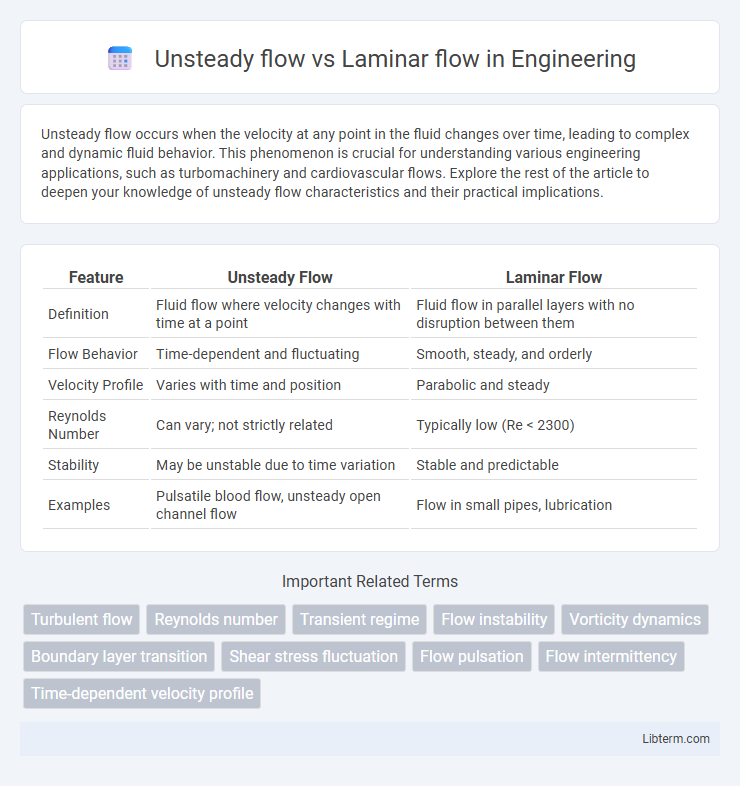Unsteady flow occurs when the velocity at any point in the fluid changes over time, leading to complex and dynamic fluid behavior. This phenomenon is crucial for understanding various engineering applications, such as turbomachinery and cardiovascular flows. Explore the rest of the article to deepen your knowledge of unsteady flow characteristics and their practical implications.
Table of Comparison
| Feature | Unsteady Flow | Laminar Flow |
|---|---|---|
| Definition | Fluid flow where velocity changes with time at a point | Fluid flow in parallel layers with no disruption between them |
| Flow Behavior | Time-dependent and fluctuating | Smooth, steady, and orderly |
| Velocity Profile | Varies with time and position | Parabolic and steady |
| Reynolds Number | Can vary; not strictly related | Typically low (Re < 2300) |
| Stability | May be unstable due to time variation | Stable and predictable |
| Examples | Pulsatile blood flow, unsteady open channel flow | Flow in small pipes, lubrication |
Introduction to Fluid Flow Types
Unsteady flow occurs when fluid velocity changes with time at any point, causing fluctuations and instabilities, whereas laminar flow is characterized by smooth, orderly layers of fluid sliding past one another with minimal mixing. In laminar flow, the Reynolds number is typically below 2,000, indicating viscous forces dominate inertial forces, maintaining flow predictability. Understanding these fluid flow types is essential for designing efficient pipelines, aerodynamics, and predicting flow behavior in engineering applications.
Defining Unsteady Flow
Unsteady flow refers to fluid motion where velocity and pressure change with time at any given point, contrasting with steady flow where these properties remain constant. It is characterized by temporal variations in flow parameters, often influenced by transient forces or changing boundary conditions. Understanding unsteady flow is essential for analyzing dynamic systems such as pulsatile blood flow, fluctuating air currents, and variable industrial fluid processes.
Understanding Laminar Flow
Laminar flow occurs when a fluid moves in smooth, parallel layers with minimal mixing between them, typically at low velocities and Reynolds numbers below 2,300. This flow regime is characterized by steady, predictable velocity profiles, making it ideal for applications requiring precision and low turbulence, such as in microfluidic devices and aerodynamic studies. Understanding laminar flow enables engineers to optimize fluid dynamics for improved efficiency and control in various scientific and industrial processes.
Key Differences Between Unsteady and Laminar Flow
Unsteady flow is characterized by changes in velocity and pressure at any given point over time, while laminar flow features smooth, orderly fluid motion with parallel layers moving at constant velocities. Unsteady flow can be either laminar or turbulent, but laminar flow specifically refers to a steady or steady-like regime with low Reynolds numbers typically below 2,300. Key differences include temporal variability in unsteady flow versus time-invariance in laminar flow, and the flow pattern's stability in laminar conditions compared to the fluctuating behavior of unsteady flow.
Characteristics of Unsteady Flow
Unsteady flow is characterized by velocity and pressure that change with time at any given point, contrasting with the steady velocity profile of laminar flow. This flow type often occurs in natural and industrial processes where fluctuating forces or transient conditions disrupt flow stability. Key features include time-dependent variations, possible turbulence onset, and complex velocity fields that defy the smooth, orderly layers typical of laminar flow.
Characteristics of Laminar Flow
Laminar flow is characterized by smooth, orderly fluid motion where layers of fluid slide past one another with minimal mixing, typically occurring at low Reynolds numbers below 2,000. Velocity profiles in laminar flow are parabolic, indicating a steady and predictable movement with little to no turbulence, which reduces shear stress and energy losses. This type of flow is common in small-diameter pipes or channels with low fluid velocity, maintaining stability and consistent flow patterns.
Factors Affecting Flow Regimes
Unsteady flow occurs when fluid velocity or direction changes over time, influenced by factors such as fluctuations in pressure, transient forces, and unsteady inlet conditions. Laminar flow is characterized by smooth, orderly fluid motion with low Reynolds numbers, typically below 2,000, depending on fluid viscosity, flow velocity, and pipe diameter. Key factors affecting these flow regimes include fluid properties, flow velocity, surface roughness, and geometric constraints, with transitions triggered by disturbances that increase the Reynolds number or introduce temporal variations.
Practical Examples: Unsteady Flow vs Laminar Flow
Unsteady flow occurs in scenarios like blood flow in arteries where velocity changes with time, whereas laminar flow is observed in smooth, steady streams such as oil flowing through a narrow pipe. In unsteady flow, velocity and pressure vary at different points over time, making it common in pulsatile systems like engine intake valves. Laminar flow, characterized by parallel fluid layers with minimal mixing, is typical in microfluidic devices and slow-moving water channels, ensuring predictable and stable fluid motion.
Industrial Applications and Relevance
Unsteady flow occurs when fluid velocity or pressure changes with time, significantly impacting processes such as pump operation and transient heat exchangers in chemical and power plants where flow conditions fluctuate rapidly. Laminar flow, characterized by smooth, orderly fluid motion, is essential in industries like pharmaceuticals and semiconductor manufacturing, ensuring precise control over fluid behavior to minimize contamination and maintain product quality. Understanding the differences between unsteady and laminar flow enables engineers to optimize equipment design and process efficiency in sectors ranging from petrochemical refining to microfluidics.
Summary and Comparative Analysis
Unsteady flow is characterized by velocity and pressure changes over time at any given point, while laminar flow maintains smooth, constant fluid motion with parallel layers and minimal mixing. Laminar flow typically occurs at low Reynolds numbers (Re < 2000), ensuring predictable flow patterns, whereas unsteady flow can occur across various flow regimes and often results in turbulent behavior when velocity fluctuations intensify. Understanding the distinction between unsteady and laminar flow is critical for optimizing fluid dynamics in engineering applications such as pipeline design, aerodynamic modeling, and chemical processing.
Unsteady flow Infographic

 libterm.com
libterm.com